Entrepreneurship Prospect
VerifiedAdded on 2023/03/23
|10
|2705
|46
AI Summary
This paper examines the entrepreneurial factors that generate success through the use of GoPro Inc. case. It identifies the factors that affect the dark side of entrepreneurship, the inborn trait of entrepreneurship, the competitive advantage of GoPro, and strategies for mitigating threats.
Contribute Materials
Your contribution can guide someone’s learning journey. Share your
documents today.

1
Entrepreneurship Prospect
Student’s Name
Institutional Affiliation
Date
Entrepreneurship Prospect
Student’s Name
Institutional Affiliation
Date
Secure Best Marks with AI Grader
Need help grading? Try our AI Grader for instant feedback on your assignments.
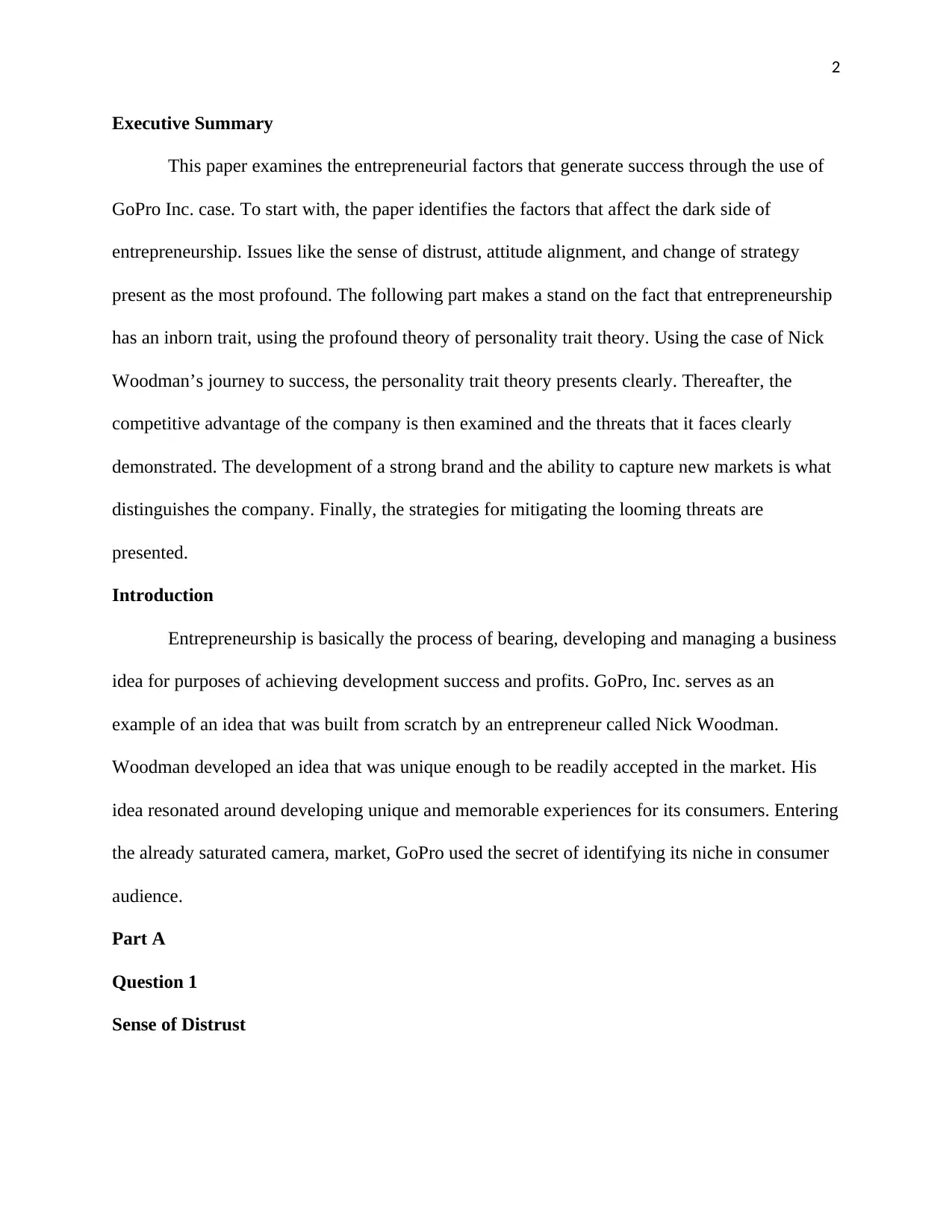
2
Executive Summary
This paper examines the entrepreneurial factors that generate success through the use of
GoPro Inc. case. To start with, the paper identifies the factors that affect the dark side of
entrepreneurship. Issues like the sense of distrust, attitude alignment, and change of strategy
present as the most profound. The following part makes a stand on the fact that entrepreneurship
has an inborn trait, using the profound theory of personality trait theory. Using the case of Nick
Woodman’s journey to success, the personality trait theory presents clearly. Thereafter, the
competitive advantage of the company is then examined and the threats that it faces clearly
demonstrated. The development of a strong brand and the ability to capture new markets is what
distinguishes the company. Finally, the strategies for mitigating the looming threats are
presented.
Introduction
Entrepreneurship is basically the process of bearing, developing and managing a business
idea for purposes of achieving development success and profits. GoPro, Inc. serves as an
example of an idea that was built from scratch by an entrepreneur called Nick Woodman.
Woodman developed an idea that was unique enough to be readily accepted in the market. His
idea resonated around developing unique and memorable experiences for its consumers. Entering
the already saturated camera, market, GoPro used the secret of identifying its niche in consumer
audience.
Part A
Question 1
Sense of Distrust
Executive Summary
This paper examines the entrepreneurial factors that generate success through the use of
GoPro Inc. case. To start with, the paper identifies the factors that affect the dark side of
entrepreneurship. Issues like the sense of distrust, attitude alignment, and change of strategy
present as the most profound. The following part makes a stand on the fact that entrepreneurship
has an inborn trait, using the profound theory of personality trait theory. Using the case of Nick
Woodman’s journey to success, the personality trait theory presents clearly. Thereafter, the
competitive advantage of the company is then examined and the threats that it faces clearly
demonstrated. The development of a strong brand and the ability to capture new markets is what
distinguishes the company. Finally, the strategies for mitigating the looming threats are
presented.
Introduction
Entrepreneurship is basically the process of bearing, developing and managing a business
idea for purposes of achieving development success and profits. GoPro, Inc. serves as an
example of an idea that was built from scratch by an entrepreneur called Nick Woodman.
Woodman developed an idea that was unique enough to be readily accepted in the market. His
idea resonated around developing unique and memorable experiences for its consumers. Entering
the already saturated camera, market, GoPro used the secret of identifying its niche in consumer
audience.
Part A
Question 1
Sense of Distrust

3
Most entrepreneurs have a sense of distrust not only to the people around them but to the
future of its business. Woodman demonstrates a huge sense of distrust as demonstrated when he
said started off alone. Having failed in the initial stages of his career when he started working on
the project of Funbug alone. The whole project went down with $3.9 million investor’s money. It
is natural that after someone fails in one project, he/she would do it a different way next time
(Burton, Sørensen and Dobrev 2016). That was not the case of Woodman because, after some
time, he embarked on another project, GoPro. As he worked on the project, he locked himself up
in his beachside bedroom. He separated himself from the normal life and that included family
and friends for the purposes of working on the project alone. That is a good indication of the
huge level of mistrust that Woodman demonstrated. Woodman also made claims that if the
project failed, he would join the workforce. That is a huge indication of distrust for the future.
Entrepreneurship does not provide an assured future because everything is based on the trial.
That invites a sense of distrust for entrepreneurs.
Attitude alignment
The alignment of attitude is also a factor that influences the dark side of entrepreneurship.
The two extreme sides of attitude alignment are the pessimistic and optimistic attitudes. The
pessimistic attitude is always the dominant attitude given the uncertainty nature of
entrepreneurship. For Woodman to resort to thinking about giving up and joining the workforce,
he must have been informed by a pessimistic attitude. For him, he had failed before and the
attitude of a pessimist had developed a great deal. For many entrepreneurs, they seem to put
themselves on the safer side by being pessimistic (Belz and Binder 2017). They create
psychological safety by waiting for the worse and if everything turns out well, they are lucky.
That is what informed Woodman to say that he would join the workforce if everything comes to
Most entrepreneurs have a sense of distrust not only to the people around them but to the
future of its business. Woodman demonstrates a huge sense of distrust as demonstrated when he
said started off alone. Having failed in the initial stages of his career when he started working on
the project of Funbug alone. The whole project went down with $3.9 million investor’s money. It
is natural that after someone fails in one project, he/she would do it a different way next time
(Burton, Sørensen and Dobrev 2016). That was not the case of Woodman because, after some
time, he embarked on another project, GoPro. As he worked on the project, he locked himself up
in his beachside bedroom. He separated himself from the normal life and that included family
and friends for the purposes of working on the project alone. That is a good indication of the
huge level of mistrust that Woodman demonstrated. Woodman also made claims that if the
project failed, he would join the workforce. That is a huge indication of distrust for the future.
Entrepreneurship does not provide an assured future because everything is based on the trial.
That invites a sense of distrust for entrepreneurs.
Attitude alignment
The alignment of attitude is also a factor that influences the dark side of entrepreneurship.
The two extreme sides of attitude alignment are the pessimistic and optimistic attitudes. The
pessimistic attitude is always the dominant attitude given the uncertainty nature of
entrepreneurship. For Woodman to resort to thinking about giving up and joining the workforce,
he must have been informed by a pessimistic attitude. For him, he had failed before and the
attitude of a pessimist had developed a great deal. For many entrepreneurs, they seem to put
themselves on the safer side by being pessimistic (Belz and Binder 2017). They create
psychological safety by waiting for the worse and if everything turns out well, they are lucky.
That is what informed Woodman to say that he would join the workforce if everything comes to
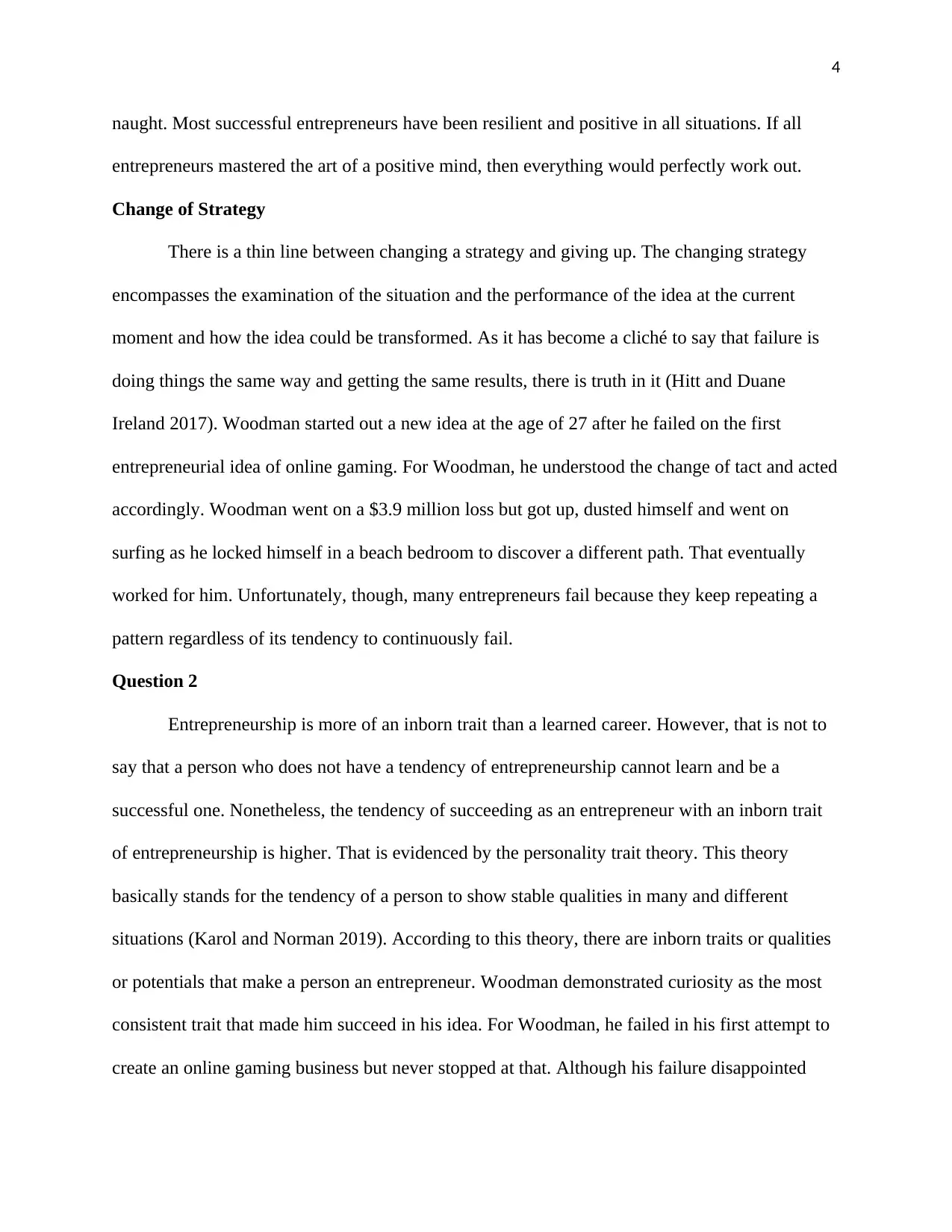
4
naught. Most successful entrepreneurs have been resilient and positive in all situations. If all
entrepreneurs mastered the art of a positive mind, then everything would perfectly work out.
Change of Strategy
There is a thin line between changing a strategy and giving up. The changing strategy
encompasses the examination of the situation and the performance of the idea at the current
moment and how the idea could be transformed. As it has become a cliché to say that failure is
doing things the same way and getting the same results, there is truth in it (Hitt and Duane
Ireland 2017). Woodman started out a new idea at the age of 27 after he failed on the first
entrepreneurial idea of online gaming. For Woodman, he understood the change of tact and acted
accordingly. Woodman went on a $3.9 million loss but got up, dusted himself and went on
surfing as he locked himself in a beach bedroom to discover a different path. That eventually
worked for him. Unfortunately, though, many entrepreneurs fail because they keep repeating a
pattern regardless of its tendency to continuously fail.
Question 2
Entrepreneurship is more of an inborn trait than a learned career. However, that is not to
say that a person who does not have a tendency of entrepreneurship cannot learn and be a
successful one. Nonetheless, the tendency of succeeding as an entrepreneur with an inborn trait
of entrepreneurship is higher. That is evidenced by the personality trait theory. This theory
basically stands for the tendency of a person to show stable qualities in many and different
situations (Karol and Norman 2019). According to this theory, there are inborn traits or qualities
or potentials that make a person an entrepreneur. Woodman demonstrated curiosity as the most
consistent trait that made him succeed in his idea. For Woodman, he failed in his first attempt to
create an online gaming business but never stopped at that. Although his failure disappointed
naught. Most successful entrepreneurs have been resilient and positive in all situations. If all
entrepreneurs mastered the art of a positive mind, then everything would perfectly work out.
Change of Strategy
There is a thin line between changing a strategy and giving up. The changing strategy
encompasses the examination of the situation and the performance of the idea at the current
moment and how the idea could be transformed. As it has become a cliché to say that failure is
doing things the same way and getting the same results, there is truth in it (Hitt and Duane
Ireland 2017). Woodman started out a new idea at the age of 27 after he failed on the first
entrepreneurial idea of online gaming. For Woodman, he understood the change of tact and acted
accordingly. Woodman went on a $3.9 million loss but got up, dusted himself and went on
surfing as he locked himself in a beach bedroom to discover a different path. That eventually
worked for him. Unfortunately, though, many entrepreneurs fail because they keep repeating a
pattern regardless of its tendency to continuously fail.
Question 2
Entrepreneurship is more of an inborn trait than a learned career. However, that is not to
say that a person who does not have a tendency of entrepreneurship cannot learn and be a
successful one. Nonetheless, the tendency of succeeding as an entrepreneur with an inborn trait
of entrepreneurship is higher. That is evidenced by the personality trait theory. This theory
basically stands for the tendency of a person to show stable qualities in many and different
situations (Karol and Norman 2019). According to this theory, there are inborn traits or qualities
or potentials that make a person an entrepreneur. Woodman demonstrated curiosity as the most
consistent trait that made him succeed in his idea. For Woodman, he failed in his first attempt to
create an online gaming business but never stopped at that. Although his failure disappointed
Secure Best Marks with AI Grader
Need help grading? Try our AI Grader for instant feedback on your assignments.
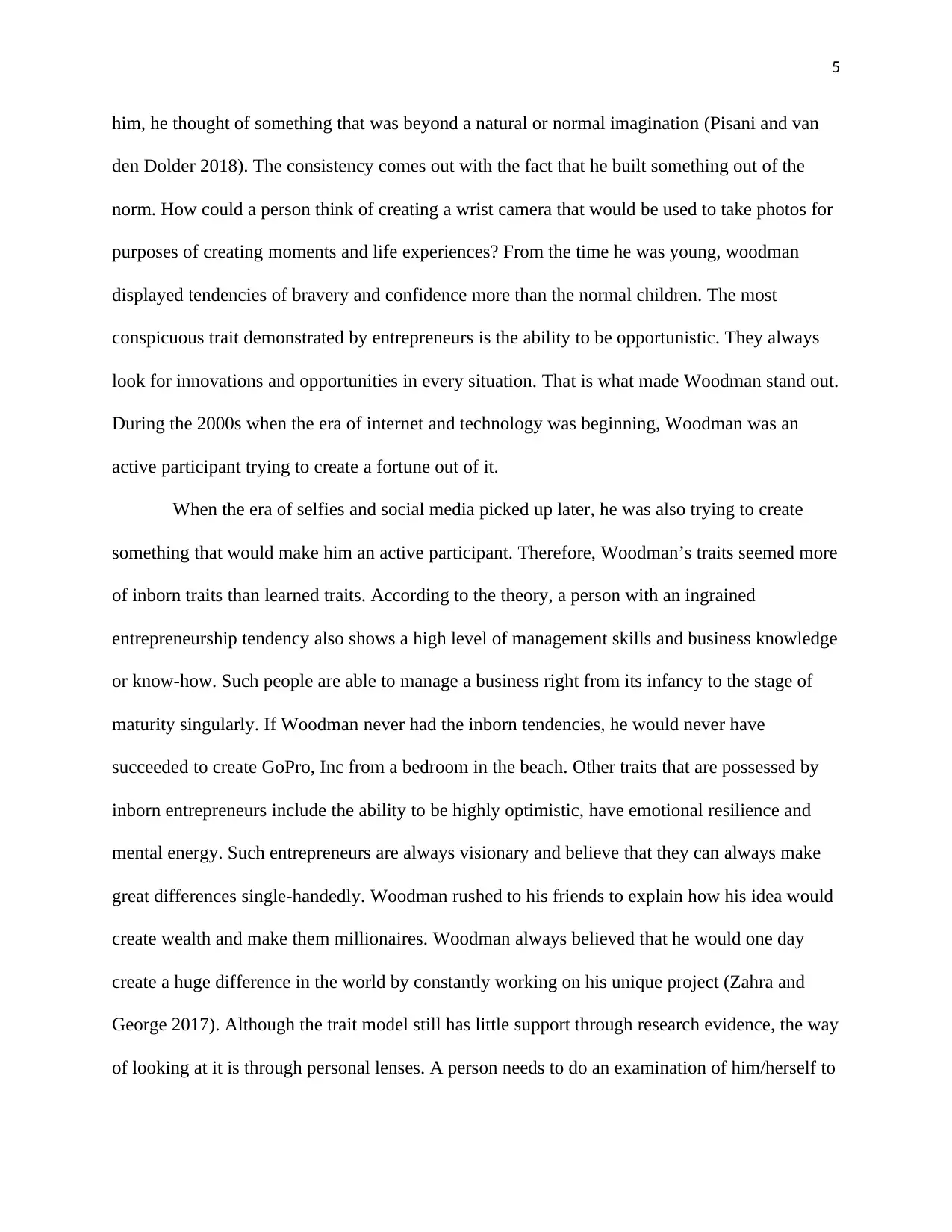
5
him, he thought of something that was beyond a natural or normal imagination (Pisani and van
den Dolder 2018). The consistency comes out with the fact that he built something out of the
norm. How could a person think of creating a wrist camera that would be used to take photos for
purposes of creating moments and life experiences? From the time he was young, woodman
displayed tendencies of bravery and confidence more than the normal children. The most
conspicuous trait demonstrated by entrepreneurs is the ability to be opportunistic. They always
look for innovations and opportunities in every situation. That is what made Woodman stand out.
During the 2000s when the era of internet and technology was beginning, Woodman was an
active participant trying to create a fortune out of it.
When the era of selfies and social media picked up later, he was also trying to create
something that would make him an active participant. Therefore, Woodman’s traits seemed more
of inborn traits than learned traits. According to the theory, a person with an ingrained
entrepreneurship tendency also shows a high level of management skills and business knowledge
or know-how. Such people are able to manage a business right from its infancy to the stage of
maturity singularly. If Woodman never had the inborn tendencies, he would never have
succeeded to create GoPro, Inc from a bedroom in the beach. Other traits that are possessed by
inborn entrepreneurs include the ability to be highly optimistic, have emotional resilience and
mental energy. Such entrepreneurs are always visionary and believe that they can always make
great differences single-handedly. Woodman rushed to his friends to explain how his idea would
create wealth and make them millionaires. Woodman always believed that he would one day
create a huge difference in the world by constantly working on his unique project (Zahra and
George 2017). Although the trait model still has little support through research evidence, the way
of looking at it is through personal lenses. A person needs to do an examination of him/herself to
him, he thought of something that was beyond a natural or normal imagination (Pisani and van
den Dolder 2018). The consistency comes out with the fact that he built something out of the
norm. How could a person think of creating a wrist camera that would be used to take photos for
purposes of creating moments and life experiences? From the time he was young, woodman
displayed tendencies of bravery and confidence more than the normal children. The most
conspicuous trait demonstrated by entrepreneurs is the ability to be opportunistic. They always
look for innovations and opportunities in every situation. That is what made Woodman stand out.
During the 2000s when the era of internet and technology was beginning, Woodman was an
active participant trying to create a fortune out of it.
When the era of selfies and social media picked up later, he was also trying to create
something that would make him an active participant. Therefore, Woodman’s traits seemed more
of inborn traits than learned traits. According to the theory, a person with an ingrained
entrepreneurship tendency also shows a high level of management skills and business knowledge
or know-how. Such people are able to manage a business right from its infancy to the stage of
maturity singularly. If Woodman never had the inborn tendencies, he would never have
succeeded to create GoPro, Inc from a bedroom in the beach. Other traits that are possessed by
inborn entrepreneurs include the ability to be highly optimistic, have emotional resilience and
mental energy. Such entrepreneurs are always visionary and believe that they can always make
great differences single-handedly. Woodman rushed to his friends to explain how his idea would
create wealth and make them millionaires. Woodman always believed that he would one day
create a huge difference in the world by constantly working on his unique project (Zahra and
George 2017). Although the trait model still has little support through research evidence, the way
of looking at it is through personal lenses. A person needs to do an examination of him/herself to
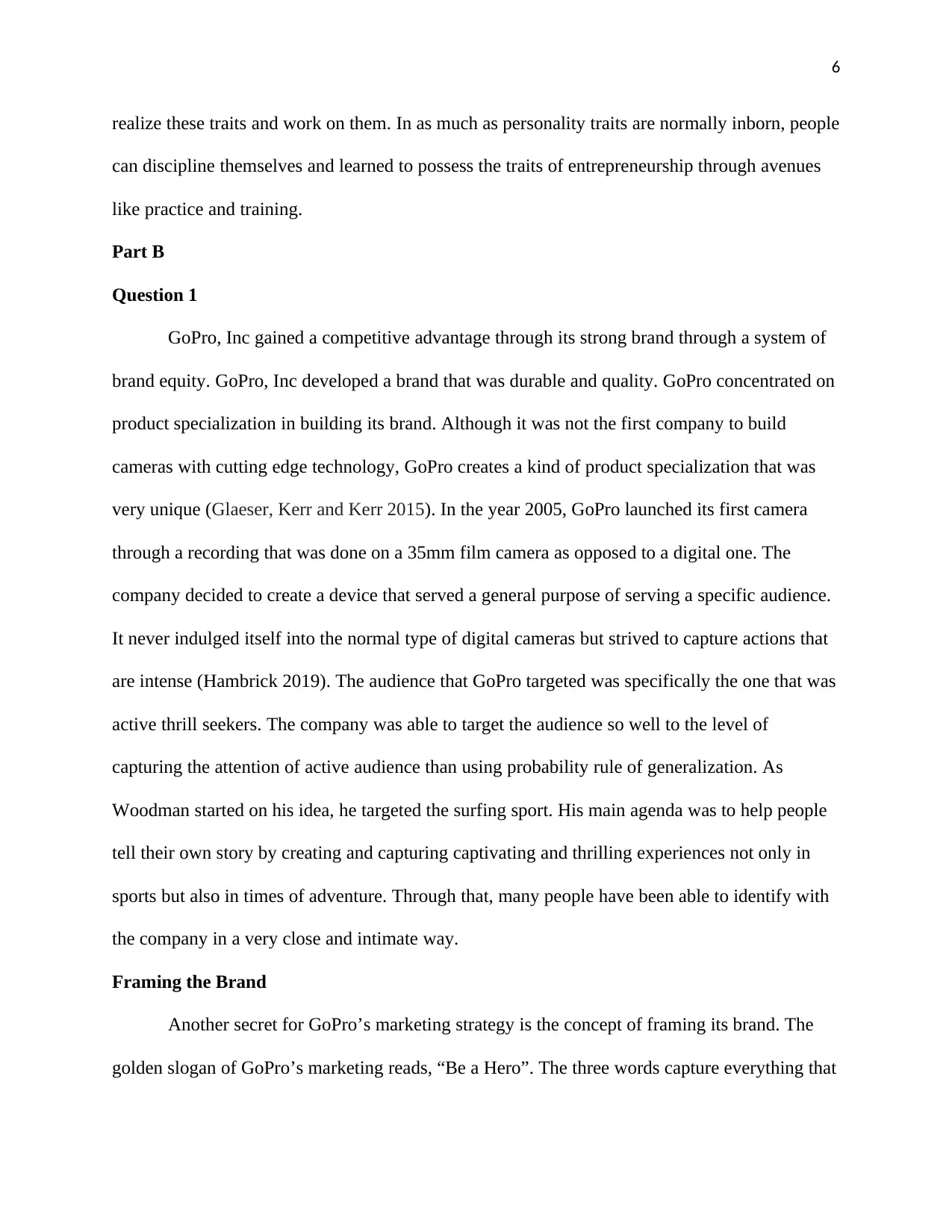
6
realize these traits and work on them. In as much as personality traits are normally inborn, people
can discipline themselves and learned to possess the traits of entrepreneurship through avenues
like practice and training.
Part B
Question 1
GoPro, Inc gained a competitive advantage through its strong brand through a system of
brand equity. GoPro, Inc developed a brand that was durable and quality. GoPro concentrated on
product specialization in building its brand. Although it was not the first company to build
cameras with cutting edge technology, GoPro creates a kind of product specialization that was
very unique (Glaeser, Kerr and Kerr 2015). In the year 2005, GoPro launched its first camera
through a recording that was done on a 35mm film camera as opposed to a digital one. The
company decided to create a device that served a general purpose of serving a specific audience.
It never indulged itself into the normal type of digital cameras but strived to capture actions that
are intense (Hambrick 2019). The audience that GoPro targeted was specifically the one that was
active thrill seekers. The company was able to target the audience so well to the level of
capturing the attention of active audience than using probability rule of generalization. As
Woodman started on his idea, he targeted the surfing sport. His main agenda was to help people
tell their own story by creating and capturing captivating and thrilling experiences not only in
sports but also in times of adventure. Through that, many people have been able to identify with
the company in a very close and intimate way.
Framing the Brand
Another secret for GoPro’s marketing strategy is the concept of framing its brand. The
golden slogan of GoPro’s marketing reads, “Be a Hero”. The three words capture everything that
realize these traits and work on them. In as much as personality traits are normally inborn, people
can discipline themselves and learned to possess the traits of entrepreneurship through avenues
like practice and training.
Part B
Question 1
GoPro, Inc gained a competitive advantage through its strong brand through a system of
brand equity. GoPro, Inc developed a brand that was durable and quality. GoPro concentrated on
product specialization in building its brand. Although it was not the first company to build
cameras with cutting edge technology, GoPro creates a kind of product specialization that was
very unique (Glaeser, Kerr and Kerr 2015). In the year 2005, GoPro launched its first camera
through a recording that was done on a 35mm film camera as opposed to a digital one. The
company decided to create a device that served a general purpose of serving a specific audience.
It never indulged itself into the normal type of digital cameras but strived to capture actions that
are intense (Hambrick 2019). The audience that GoPro targeted was specifically the one that was
active thrill seekers. The company was able to target the audience so well to the level of
capturing the attention of active audience than using probability rule of generalization. As
Woodman started on his idea, he targeted the surfing sport. His main agenda was to help people
tell their own story by creating and capturing captivating and thrilling experiences not only in
sports but also in times of adventure. Through that, many people have been able to identify with
the company in a very close and intimate way.
Framing the Brand
Another secret for GoPro’s marketing strategy is the concept of framing its brand. The
golden slogan of GoPro’s marketing reads, “Be a Hero”. The three words capture everything that
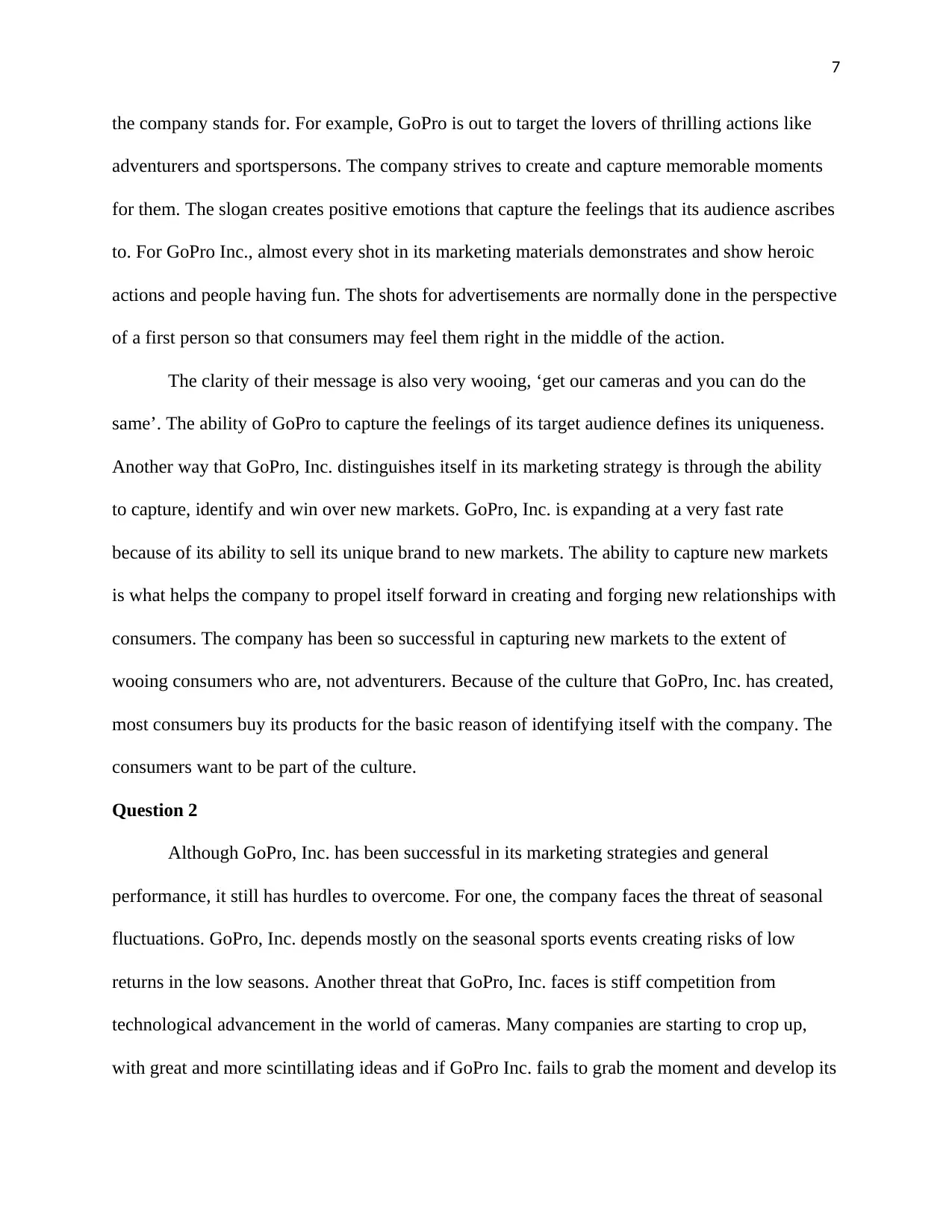
7
the company stands for. For example, GoPro is out to target the lovers of thrilling actions like
adventurers and sportspersons. The company strives to create and capture memorable moments
for them. The slogan creates positive emotions that capture the feelings that its audience ascribes
to. For GoPro Inc., almost every shot in its marketing materials demonstrates and show heroic
actions and people having fun. The shots for advertisements are normally done in the perspective
of a first person so that consumers may feel them right in the middle of the action.
The clarity of their message is also very wooing, ‘get our cameras and you can do the
same’. The ability of GoPro to capture the feelings of its target audience defines its uniqueness.
Another way that GoPro, Inc. distinguishes itself in its marketing strategy is through the ability
to capture, identify and win over new markets. GoPro, Inc. is expanding at a very fast rate
because of its ability to sell its unique brand to new markets. The ability to capture new markets
is what helps the company to propel itself forward in creating and forging new relationships with
consumers. The company has been so successful in capturing new markets to the extent of
wooing consumers who are, not adventurers. Because of the culture that GoPro, Inc. has created,
most consumers buy its products for the basic reason of identifying itself with the company. The
consumers want to be part of the culture.
Question 2
Although GoPro, Inc. has been successful in its marketing strategies and general
performance, it still has hurdles to overcome. For one, the company faces the threat of seasonal
fluctuations. GoPro, Inc. depends mostly on the seasonal sports events creating risks of low
returns in the low seasons. Another threat that GoPro, Inc. faces is stiff competition from
technological advancement in the world of cameras. Many companies are starting to crop up,
with great and more scintillating ideas and if GoPro Inc. fails to grab the moment and develop its
the company stands for. For example, GoPro is out to target the lovers of thrilling actions like
adventurers and sportspersons. The company strives to create and capture memorable moments
for them. The slogan creates positive emotions that capture the feelings that its audience ascribes
to. For GoPro Inc., almost every shot in its marketing materials demonstrates and show heroic
actions and people having fun. The shots for advertisements are normally done in the perspective
of a first person so that consumers may feel them right in the middle of the action.
The clarity of their message is also very wooing, ‘get our cameras and you can do the
same’. The ability of GoPro to capture the feelings of its target audience defines its uniqueness.
Another way that GoPro, Inc. distinguishes itself in its marketing strategy is through the ability
to capture, identify and win over new markets. GoPro, Inc. is expanding at a very fast rate
because of its ability to sell its unique brand to new markets. The ability to capture new markets
is what helps the company to propel itself forward in creating and forging new relationships with
consumers. The company has been so successful in capturing new markets to the extent of
wooing consumers who are, not adventurers. Because of the culture that GoPro, Inc. has created,
most consumers buy its products for the basic reason of identifying itself with the company. The
consumers want to be part of the culture.
Question 2
Although GoPro, Inc. has been successful in its marketing strategies and general
performance, it still has hurdles to overcome. For one, the company faces the threat of seasonal
fluctuations. GoPro, Inc. depends mostly on the seasonal sports events creating risks of low
returns in the low seasons. Another threat that GoPro, Inc. faces is stiff competition from
technological advancement in the world of cameras. Many companies are starting to crop up,
with great and more scintillating ideas and if GoPro Inc. fails to grab the moment and develop its
Paraphrase This Document
Need a fresh take? Get an instant paraphrase of this document with our AI Paraphraser

8
ideas to be more competitive, it risks being overtaken. Major companies like Sony are also
developing more competitive technological advancements in the media world. They have the eye
of overtaking such companies as GoPro Inc. by learning from their mistakes and developing
more competitive products (Hardy 2018). The company also faces the risk of price competition
from cheap Chinese brands. The rise of supply also offers a great risk for the company because it
will consequently affect pricing mechanisms. Another looming threat is the sinking global
photographic market for equipment. Many people are opting for phone cameras because of
convenience. The embodiment of powerful cameras in mobile phones has made it possible for
people to share memorable experiences at the comfort of their phones. There are just too many
cameras around. Everybody with a smartphone has a camera and will not be tempted to invest in
another camera. Therefore, the high level of saturation of cameras in the market is a huge threat
for GoPro, Inc, in the coming years.
To effectively mitigate the threats above, GoPro must take necessary actions of utilizing
the opportunities that present itself. That is because opportunities mark the future of the market
trend. Some of the opportunities that GoPro must utilize include; the presence of a strong social
network, the rise of virtual reality technology, a high potential for drone the market and the rise
of the market of action cameras.
Conclusion
GoPro stands a great chance in maintaining a dominant market. The Company has all it
takes for an entrepreneur company to maintain success. The future of technology and the
economic and business environment is, however, the major risk factor in achieving and
maintaining its success. The best way GoPro Inc. will succeed is to take advantage of the
opportunities that present itself.
ideas to be more competitive, it risks being overtaken. Major companies like Sony are also
developing more competitive technological advancements in the media world. They have the eye
of overtaking such companies as GoPro Inc. by learning from their mistakes and developing
more competitive products (Hardy 2018). The company also faces the risk of price competition
from cheap Chinese brands. The rise of supply also offers a great risk for the company because it
will consequently affect pricing mechanisms. Another looming threat is the sinking global
photographic market for equipment. Many people are opting for phone cameras because of
convenience. The embodiment of powerful cameras in mobile phones has made it possible for
people to share memorable experiences at the comfort of their phones. There are just too many
cameras around. Everybody with a smartphone has a camera and will not be tempted to invest in
another camera. Therefore, the high level of saturation of cameras in the market is a huge threat
for GoPro, Inc, in the coming years.
To effectively mitigate the threats above, GoPro must take necessary actions of utilizing
the opportunities that present itself. That is because opportunities mark the future of the market
trend. Some of the opportunities that GoPro must utilize include; the presence of a strong social
network, the rise of virtual reality technology, a high potential for drone the market and the rise
of the market of action cameras.
Conclusion
GoPro stands a great chance in maintaining a dominant market. The Company has all it
takes for an entrepreneur company to maintain success. The future of technology and the
economic and business environment is, however, the major risk factor in achieving and
maintaining its success. The best way GoPro Inc. will succeed is to take advantage of the
opportunities that present itself.
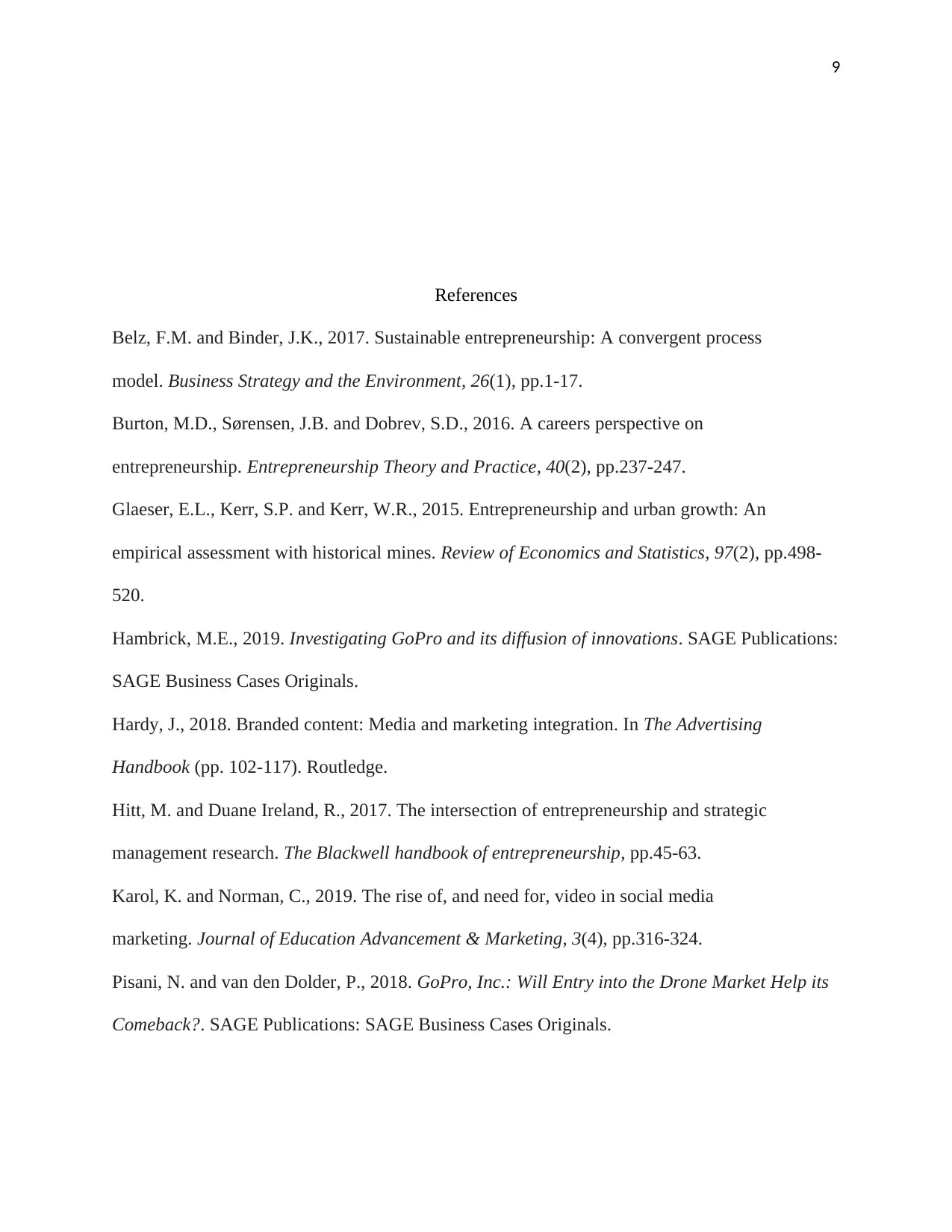
9
References
Belz, F.M. and Binder, J.K., 2017. Sustainable entrepreneurship: A convergent process
model. Business Strategy and the Environment, 26(1), pp.1-17.
Burton, M.D., Sørensen, J.B. and Dobrev, S.D., 2016. A careers perspective on
entrepreneurship. Entrepreneurship Theory and Practice, 40(2), pp.237-247.
Glaeser, E.L., Kerr, S.P. and Kerr, W.R., 2015. Entrepreneurship and urban growth: An
empirical assessment with historical mines. Review of Economics and Statistics, 97(2), pp.498-
520.
Hambrick, M.E., 2019. Investigating GoPro and its diffusion of innovations. SAGE Publications:
SAGE Business Cases Originals.
Hardy, J., 2018. Branded content: Media and marketing integration. In The Advertising
Handbook (pp. 102-117). Routledge.
Hitt, M. and Duane Ireland, R., 2017. The intersection of entrepreneurship and strategic
management research. The Blackwell handbook of entrepreneurship, pp.45-63.
Karol, K. and Norman, C., 2019. The rise of, and need for, video in social media
marketing. Journal of Education Advancement & Marketing, 3(4), pp.316-324.
Pisani, N. and van den Dolder, P., 2018. GoPro, Inc.: Will Entry into the Drone Market Help its
Comeback?. SAGE Publications: SAGE Business Cases Originals.
References
Belz, F.M. and Binder, J.K., 2017. Sustainable entrepreneurship: A convergent process
model. Business Strategy and the Environment, 26(1), pp.1-17.
Burton, M.D., Sørensen, J.B. and Dobrev, S.D., 2016. A careers perspective on
entrepreneurship. Entrepreneurship Theory and Practice, 40(2), pp.237-247.
Glaeser, E.L., Kerr, S.P. and Kerr, W.R., 2015. Entrepreneurship and urban growth: An
empirical assessment with historical mines. Review of Economics and Statistics, 97(2), pp.498-
520.
Hambrick, M.E., 2019. Investigating GoPro and its diffusion of innovations. SAGE Publications:
SAGE Business Cases Originals.
Hardy, J., 2018. Branded content: Media and marketing integration. In The Advertising
Handbook (pp. 102-117). Routledge.
Hitt, M. and Duane Ireland, R., 2017. The intersection of entrepreneurship and strategic
management research. The Blackwell handbook of entrepreneurship, pp.45-63.
Karol, K. and Norman, C., 2019. The rise of, and need for, video in social media
marketing. Journal of Education Advancement & Marketing, 3(4), pp.316-324.
Pisani, N. and van den Dolder, P., 2018. GoPro, Inc.: Will Entry into the Drone Market Help its
Comeback?. SAGE Publications: SAGE Business Cases Originals.

10
Zahra, S.A. and George, G., 2017. International entrepreneurship: the current status of the field
and future research agenda. Strategic entrepreneurship: Creating a new mindset, pp.253-288.
Zahra, S.A. and George, G., 2017. International entrepreneurship: the current status of the field
and future research agenda. Strategic entrepreneurship: Creating a new mindset, pp.253-288.
1 out of 10
Related Documents
Your All-in-One AI-Powered Toolkit for Academic Success.
+13062052269
info@desklib.com
Available 24*7 on WhatsApp / Email
![[object Object]](/_next/static/media/star-bottom.7253800d.svg)
Unlock your academic potential
© 2024 | Zucol Services PVT LTD | All rights reserved.




